
Many people outside of New Mexico associate the Land of Enchantment with hot, dry deserts and the occasional UFO crash. However, New Mexico’s climate is as diverse as its people, ranging from the Sangre de Cristo Mountains to the arid southwest. Here are the best types of grass seed for New Mexico lawns.
For a quick guide, skip ahead to our section on how to choose the best grass type for your New Mexico lawn.
New Mexico’s Climate
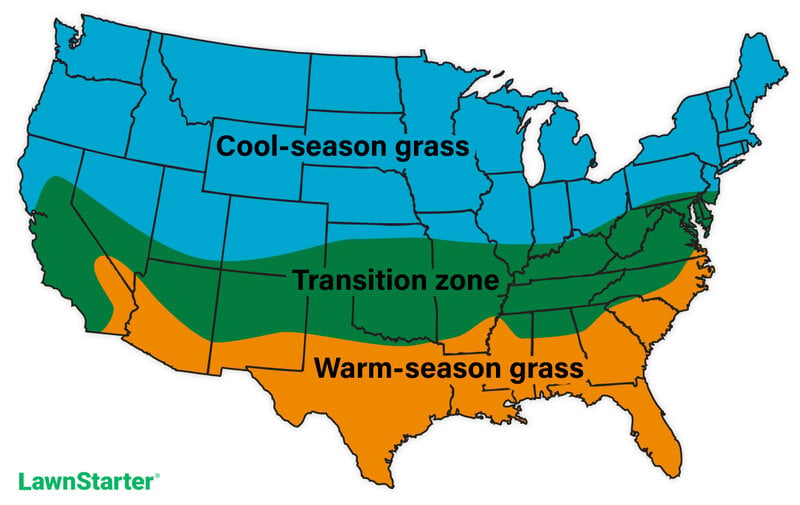
Turfgrasses are divided into cool-season and warm-season grasses. Due to variations in elevation in New Mexico, cool-season grasses thrive north of Socorro, while warm-season grasses are more suited to the state’s southern region. However, most of the state is in the transition zone, where it’s possible to grow both grass types.
When selecting a grass type for your New Mexico lawn, it’s crucial to consider factors such as soil type, sunlight exposure, and water availability. You can have a beautiful and healthy lawn anywhere in New Mexico with the right grass type and proper maintenance.
Cool-Season Grasses
Cool-season grasses thrive in cooler climates, growing in the spring and autumn and going dormant in the summer and winter. You can grow cool-season grasses in the Midwest, Northwest, and Northeast portions of New Mexico. Where water is an issue, cold-tolerant warm-season grasses are a better option.
1. Fine Fescues
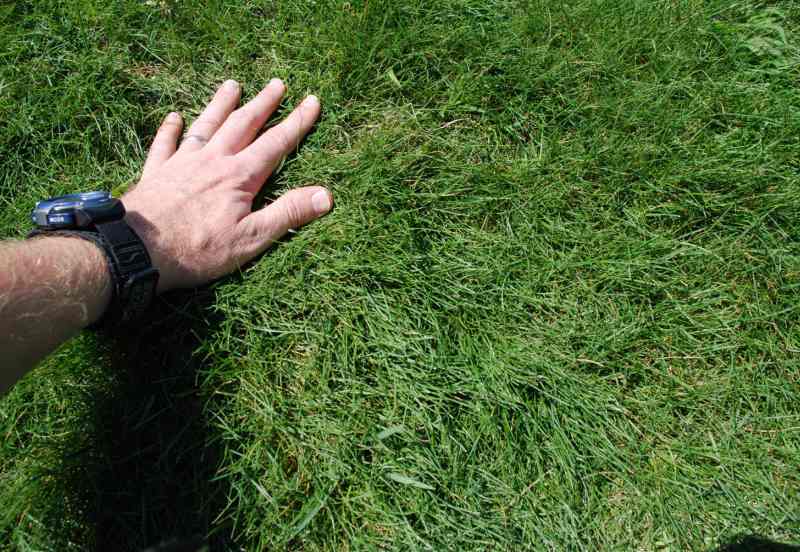
Aaron J. Patton, Ph.D. / Turfgrass Extension Specialist at Purdue University
New Mexico homeowners who want a low-maintenance lawn that can grow in the shade should consider fine fescue grasses. These fine-leaved, cool-season grasses can thrive in the shady areas of lawns where other grasses struggle to grow. Fine fescues are drought-resistant and don’t handle foot traffic well.
Classification: Cool-season grass
Spreads by: Creeping red fescue spreads by rhizomes, while other fine fescues are bunch-type grasses, such as chewing, hard, and sheep fescues.
Shade tolerance: Moderate to High, depending on species
Drought tolerance: Moderate to High, depending on species
Foot traffic tolerance: Low to Moderate, depending on species
Maintenance needs: Low fertilizer and mowing needs
Mowing height: Set mowing height between 2.5 and 4 inches, depending on species.
Potential for disease: Moderate. Common diseases include red thread, leaf spot, dollar spot, summer patch, and powdery mildew.
Soil pH: 6-6.5
Soil type: Sandy, clay, or rocky soil. Will not perform well in wet soil conditions. Prefers drier soils.
Other notes: All varieties are tolerant of shade and have delicate leaves, making them ideal for lawns in areas with many trees or in other shady locations.
Grass Seed Options:
– Outsidepride Legacy Fine Fescue Grass Seed (5 lbs.)
– Eretz Creeping Red Fine Fescue Seed (choose your size)
– Outsidepride Creeping Red Fine Fescue Grass Seed (25 lbs.)
– Outsidepride Hard Fine Fescue Grass Seed (10 lbs.)
2. Kentucky Bluegrass

Photo Credit: Shutterstock
Kentucky bluegrass is a good choice for high-traffic yards in New Mexico. It needs moderate watering and fertilizer. It may not be the best grass for hot, dry summers as it needs more water, but newer varieties require less irrigation and can tolerate more heat, making them suitable for all of New Mexico.
Classification: Cool-season grass
Spreads by: Rhizomes
Shade tolerance: Low
Drought tolerance: Moderate
Foot traffic tolerance: Moderate
Maintenance needs: Moderate mowing frequency and high fertilization needs.
Mowing height: Set mowing height between 2.5 and 3.5 inches.
Potential for disease: Moderate to high; prone to several diseases, such as dollar spot, leaf spot, necrotic ring spot, summer patch, and stripe smut.
Soil pH: 6-7.5
Soil type: Performs best in well-drained, heavy soils with high fertility.
Other notes: This grass can self-repair and is good for high-traffic areas. It’s not ideal for drought-prone areas due to its high water requirements.
Grass Seed Options:
– Jonathan Green (11970) Blue Panther Kentucky Bluegrass Grass Seed (3 lbs.)
– SeedRanch Midnight Kentucky Bluegrass Seed (5 lbs.)
3. Perennial Ryegrass
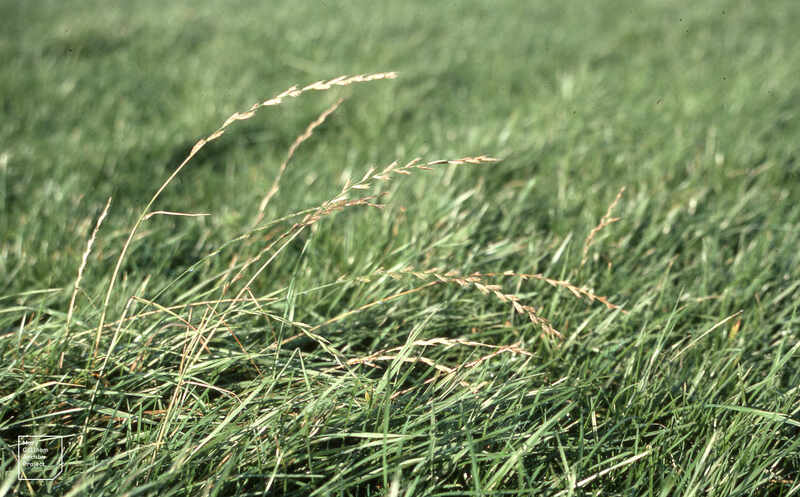
Photo Credit: Dr Mary Gillham Archive Project / Flickr / CC BY 2.0
In New Mexico, this cool-season grass is an excellent choice for overseeding mixtures. It grows swiftly and can withstand foot traffic. Because it can be overseeded on warm-season grasses throughout the cooler months, perennial ryegrass is a popular choice for homeowners who want a green lawn all year.
Classification: Cool-season grass
Spreads by: Has a bunch-type growth habit
Shade tolerance: Low
Drought tolerance: Low
Foot traffic tolerance: High
Maintenance needs: Moderate mowing and fertilization requirements. Thatch is not significant.
Mowing height: Set mowing height to 1.5 to 2.5 inches
Potential for disease: High. Common diseases include gray leaf spot, red thread, and leaf spot/melting-out.
Soil pH: Can grow in soils with a pH between 5 and 8 but prefers between 6 and 7.
Soil type: Prefers good drainage and fertility but can tolerate some poor drainage.
Other notes: Improved perennial ryegrass varieties are popular because they adapt to most of the state, take little time to establish, tolerate cold, and have good color. Modern varieties can also tolerate southern New Mexico summers because they are more heat-tolerant.
Grass Seed Options:
– Outsidepride Perennial Ryegrass Seed (5 lbs.)
– Eretz ProTurf Perennial Ryegrass Fine Lawn Seed (choose your size)
4. Tall Fescue

Aaron J. Patton, Ph.D. / Turfgrass Extension Specialist at Purdue University
Tall fescue is a popular cool-season grass with a medium to coarse texture. While it may not tolerate cold as well as other cool-season grasses, tall fescue is a popular choice in cooler regions like Gallup and Santa Fe due to its ability to endure drought and water restrictions. Tall fescue lawns can be planted via sod or seed.
Classification: Cool-season grass
Spreads by: Produce short rhizomes but have a bunch-type growth habit
Shade tolerance: Moderate
Drought tolerance: Moderate to High
Foot traffic tolerance: Moderate
Maintenance needs: Tall fescue has low to moderate maintenance needs but requires frequent mowing.
Mowing height: Set mowing height to 2 inches when the grass reaches 3 inches tall.
Potential for disease: Tolerant of most diseases when adequately maintained.
Soil pH: 5.5-6.5
Soil type: Adapted to various soil types but prefers fertile clay soils with good drainage.
Other notes: Overall, if you’re looking for low-maintenance, drought-resistant grass for your lawn, tall fescue might be the perfect choice.
Grass Seed Options:
– Triple-Play Tall Fescue Grass Seed Blend (5000 sq ft)
– Eretz Kentucky 31 K31 Tall Fescue Grass Seed (choose your size)
– Pennington The Rebels Tall Fescue Grass Seed Mix (7 lb.)
Warm-Season Grasses
The southern section of New Mexico is ideal for growing warm-season grasses. Improved warm-season grasses are more cold-tolerant and can grow across New Mexico without being lost to winter freezes. However, warm-season grasses will go dormant and lose their color for at least five months of the year.
5. Buffalograss
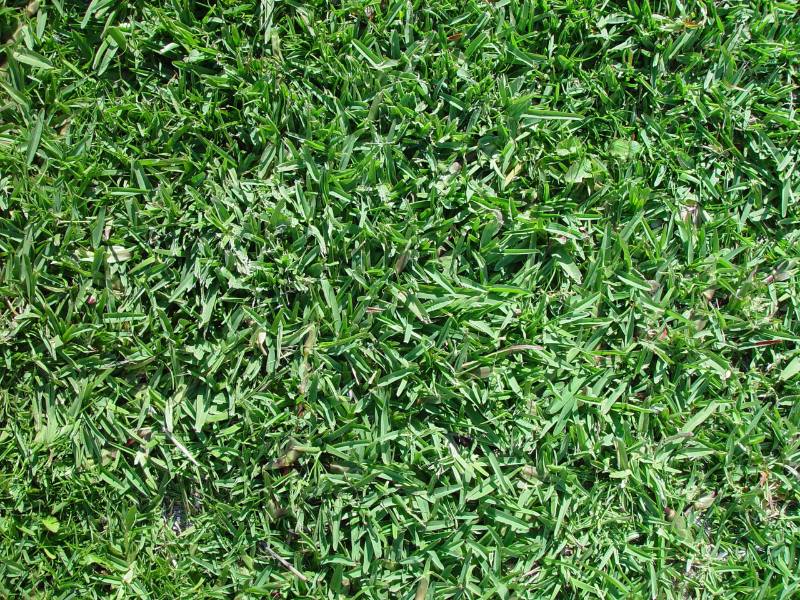
Photo Credit: Pixnio
A low-maintenance, drought-resistant native grass that grows well in the hot and dry climate of New Mexico. It is resistant to pests and diseases and requires less water use than cool-season grasses. Buffalograss has soft, green blades and is ideal for homeowners who want to minimize lawn maintenance.
Classification: Warm-season grass
Spreads by: Stolons
Shade tolerance: Low
Drought tolerance: High
Foot traffic tolerance: Low
Maintenance needs: Low fertilizer and mowing needs. Requires weed control.
Mowing height: Set the mowing height between 2 and 3 inches.
Potential for disease: Good tolerance against diseases and insects
Soil pH: 6.5-7.5
Soil type: Native clay soils, not sandy soils
Other notes: New buffalograss varieties are available that need less watering. Most of the newer types require more weed control at the beginning of planting.
Grass Seed Options:
– Everwilde Farms Buffalograss Seeds (1 lb. of seeds)
– Buffalograss seed (primed) (5-lb. bag)
6. Bermudagrass
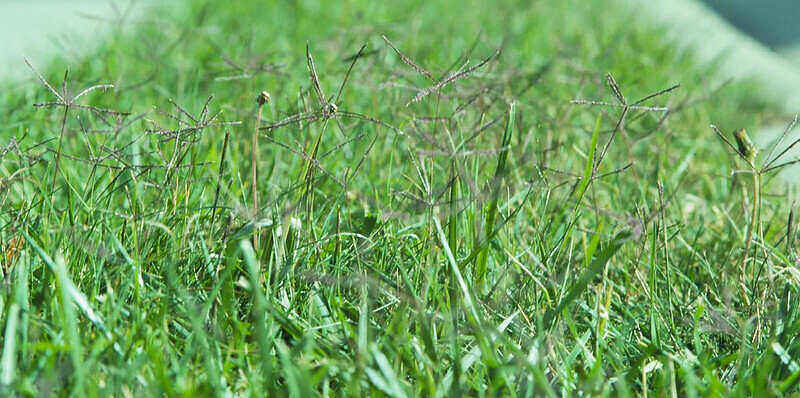
Photo Credit: Matt Lavin / Flickr / CC BY-SA 2.0
This warm-season grass thrives in New Mexico’s hot climate, making it a popular choice for athletic fields, golf courses, and lawns. It is drought-resistant and can handle heavy foot traffic.
Bermudagrass has strong roots and an attractive green color and is an option for a sustainable lawn in the desert. It’s soft texture and hardy nature make it a go-to option for homeowners from Albuquerque to Las Cruces.
Classification: Warm-season grass
Spreads by: Stolons and rhizomes
Shade tolerance: Low; thrives in full sun
Drought tolerance: High
Foot traffic tolerance: High
Maintenance needs: Mow your grass every 3 to 7 days. In the growing season, fertilize your lawn based on soil test results and fertilizer guidelines. It has low to moderate water requirements.
Mowing height: Mow common Bermudagrass down to 1.5 to 2.5 inches. For hybrid Bermudagrass cultivars (rarely used for home lawns), set the mowing deck between 0.5 and 1.5 inches
Potential for disease: Disease resistance is good, although diseases are common; low insect resistance
Soil pH: 6-6.5
Soil type: Tolerates most soil types
Other notes: Bermudagrass produces a lot of pollen, so don’t let it flower if you have grass allergies.
Grass Seed Options:
– Scotts Turf Builder Bermudagrass (10-lb. bag)
– Hancock Seed Co. Bermudagrass (50-lb. bag)
7. St. Augustinegrass
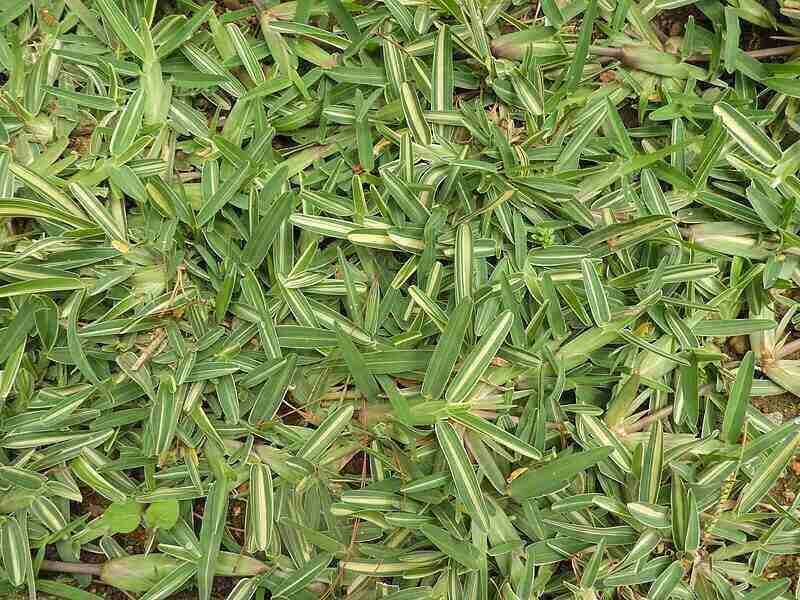
Photo Credit: Yercaud-elango / Wikimedia Commons / CC BY-SA 4.0
St. Augustinegrass is an excellent choice for lawns in most of New Mexico, except in the mountains (sorry, Taos). It produces a thick, blue-green lawn that can tolerate some shade and hot, humid summers. It is frequently used for high-traffic areas, such as parks and sports fields because it recovers quickly from damage.
However, you have to care for St. Augustine with regular maintenance. To care for it, water deeply and infrequently, mow at the correct height, and fertilize as needed. Watch out for pests like chinch bugs and diseases like brown patch fungus. Keep up with these steps to maintain a beautiful lawn throughout the growing season.
Classification: Warm-season grass
Spreads by: Stolons
Shade tolerance: Moderate. It is the most shade-tolerant warm-season grass.
Drought tolerance: Moderate
Foot traffic tolerance: Low
Maintenance needs: Mow your lawn every 5 to 7 days. St. Augustine has moderate water needs.
Mowing height: Set the mower height between 3.5 and 4 inches.
Potential for disease: Moderate to high
Soil pH: 6-7.5
Soil type: Tolerates many soil types; prefers moderately fertile, moist soils that are not waterlogged; won’t grow in compacted soils
Other notes: Thatch buildup is a common issue, and it is recommended to dethatch when its thickness exceeds 3/4 inch. Infestations of fungi and insects are also common problems for St. Augustinegrass.
Grass Plug Options:
– Seed Ranch St Augustine Seville Grass Plugs (2 Trays)
– Seed Ranch St Augustine Floratam Grass Plugs (2 Trays)
8. Zoysiagrass
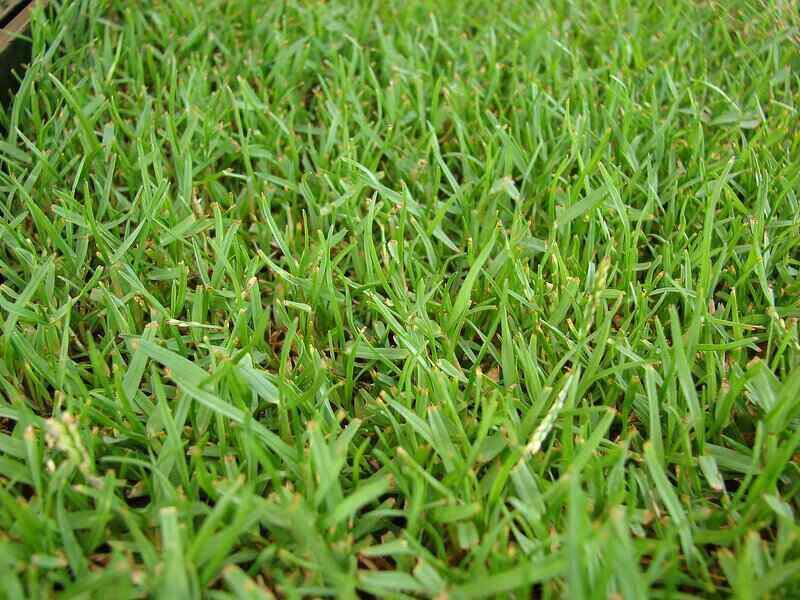
Photo Credit: Forest & Kim Starr / Wikimedia Commons / CC BY 3.0 US
Zoysiagrass is a warm-season grass well-suited for New Mexico’s hot and dry climate. It is one of the top 10 drought-tolerant grasses and requires little maintenance. Zoysia is known for its dense growth, making it a popular choice for homeowners who want a lush, green lawn that chokes out weeds. This grass is adapted statewide.
Classification: Warm-season grass
Spreads by: Stolons and rhizomes
Shade tolerance: Moderate
Drought tolerance: Moderate
Foot traffic tolerance: High, but recovers slowly from damage
Maintenance needs: Mow every 5 to 10 days. It requires a little nitrogen fertilizer but is prone to thatch buildup.
Mowing height: Set mowing height between 1 and 2 inches
Potential for disease: Good disease tolerance
Soil pH: 6-6.5
Soil type: Well-draining. Some cultivars are more tolerant of a wide range of soils than others.
Other notes: Zoysias are cold-hardy (some cultivars are more cold-tolerant than others) and can survive in partial shade. While great at self-repair, it does grow (and repair) slowly, so it’s best to establish Zoysia with sod.
Grass Plug and Seed Options:
– Zoysia Plugs (50 Large Grass Plugs)
– Zoysia Plugs (50 Full & Lush Grass Plugs)
– Zoysia Plugs (100 Plugs)
– Zenith Zoysia Grass Seeds (1/8 lb. of seeds)
9. Blue Grama
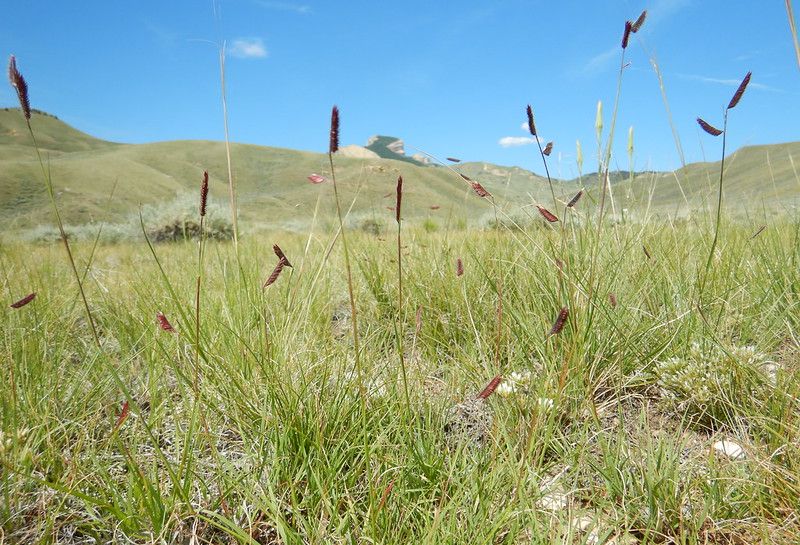
Matt Lavin / Flickr / CC BY-SA 2.0
Blue grama is a warm-season perennial commonly found in New Mexico as forage for cattle. While it won’t give you a traditional lawn look, this native grass can grow up to 4 feet tall, and the curly purplish combs are a good option for drought-resistant landscaping.
Classification: Warm-season
Spreads by: Rhizomes
Shade Tolerance: Low
Drought Tolerance: High
Foot Traffic Tolerance: Low
Maintenance Needs: Low maintenance requirements
Mowing Height: Set mowing height between 2 and 3 inches
Potential for Disease: Low to Moderate. Its most prevalent disease is fungal rust.
Soil pH: 6.6-8.4
Soil Type: Tolerates a wide range of soil textures, including clays and sandy or gravelly loams. Does not perform well in wet, poorly drained soils.
Other Notes: Blue grama is the New Mexico state grass and thrives from the lowest points in the state up to heights of 8,000 feet in elevation.
How to Choose the Best Grass Type for Your New Mexico Lawn
When selecting grass for your lawn in New Mexico, there are several factors to consider. Narrow down your options by identifying whether you are located in the warm or cool region of the state. From there, choose a grass that blends well with the landscape and helps prevent weed growth.
- Low-maintenance: In southern New Mexico, buffalograss is a good choice. For cool-season grass, newer varieties of Kentucky bluegrass and tall fescue are popular options.
- Poor soil: Consider Bermudagrass, buffalograss, or fine fescues, which can grow in poor soil conditions.
- Shade-tolerant: Fine fescues thrive in shady areas, while Zoysia, tall fescue, and St. Augustinegrass can tolerate partial shade.
- High-traffic: Bermudagrass and Zoysia resist heavy traffic and pet damage.
FAQ: Best Grass Types for New Mexico
According to New Mexico State University, the best time to plant your lawn is April to June for warm-season grasses and late summer to early fall for cool-season grasses.
Absolutely, yes. Xeriscaping is a great option in New Mexico. This method of landscaping uses less water and benefits the local ecosystem. Native grasses and plants are well-suited for this water-saving landscape design.
Tall fescue is a popular turfgrass for Santa Fe and cooler regions in northern New Mexico. Its deep roots steel this grass against drought, and its ability to tolerate partial shade make it a favorite for homeowners with partial shade lawns.
When to Call a Pro
Before investing in expensive turf for your yard, remember the time you have available for maintenance. Even the highest quality grass won’t increase the value of your home if it’s not properly taken care of. Contact one of our local lawn care pros for help establishing your lawn or choosing the best type of grass.
Looking for lawn care experts in your city? Lawnstarter has pros in Albuquerque, Santa Fe, and in other cities to handle all your lawn care needs in the “Land of Mañana” today.
Additional source:
Main Image Credit: Nickmanpow / Wikimedia Commons / CC BY-SA 3.0
LawnStarter participates in the Amazon Services LLC Associates Program, an affiliate advertising program. LawnStarter may earn revenue from products promoted in this article.